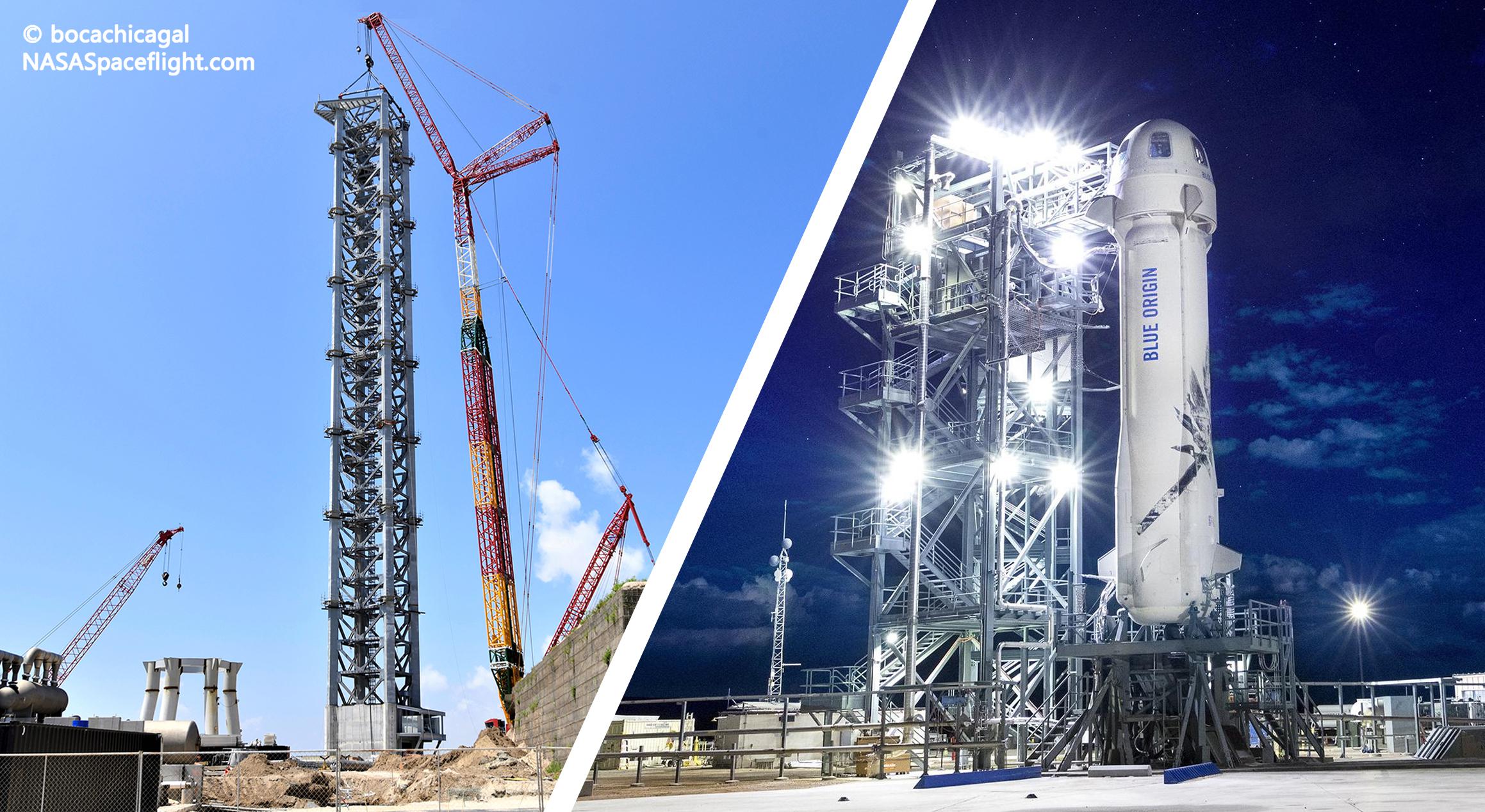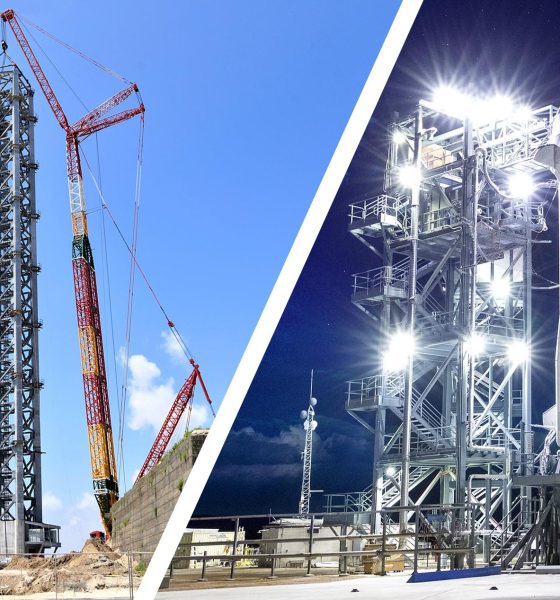

News
SpaceX tops off Starship launch tower during Blue Origin crew launch briefing
On Sunday morning, SpaceX began the process of installing the last prefabricated section of Starship’s skyscraper-sized ‘launch tower’ around the same time as startup Blue Origin kicked off a preflight briefing for its first crewed suborbital launch.
Though both events are almost entirely unconnected and have no immediate impact on each other, the simultaneity almost immediately triggered comparisons between one of the most important media briefings in Blue Origin’s 21-year history and an average busy day at SpaceX’s South Texas Starship factory and launch site. Almost exclusively funded by Amazon founder and CEO Jeff Bezos since it was founded in September 2000, around two years before SpaceX, Blue Origin is on the cusp of its first crewed launch less than two weeks after Virgin Galactic completed its first fully-crewed test flight above 80 km (~50 mi).
Approximately 600 miles southeast of Blue Origin’s Van Horn, Texas launch and test facilities, in a different corner of the vast state, SpaceX was preparing for the latest in a long line of steps towards the completion of an orbital launch site for Starship – potentially the first fully reusable orbital rocket ever built.
First revealed more than three months ago in a cryptic post from owner Jeff Bezos, Blue Origin is scheduled to launch passengers on its New Shepard rocket for the first time ever, marking the end of an extraordinarily long development period. Designed to be fully reusable, New Shepard is a small single-stage rocket powered by one liquid hydrogen and oxygen-fueled BE-3 engine capable of producing approximately 500 kN (110,000 lbf) of thrust at liftoff. Designed exclusively for the purpose of ferrying a few tourists above a mostly arbitrary 100 km (~62 mi) line separating Earth’s atmosphere and “space,” New Shepard is about the same diameter as SpaceX’s Falcon 9 and Falcon Heavy rockets but is just 15m (~50 ft) tall.
The small rocket launched for the first time in April 2015 and reached an apogee of ~94 km but instability ultimately destroyed the first New Shepard booster during its first landing attempt. Blue Origin successfully launched and landed New Shepard on its next test flight in November 2015, culminating in Bezos’ infamous “Welcome to the club!” comment after SpaceX successfully recovered a Falcon 9 booster for the first time one month later.
As of July 2021, Blue Origin has completed just 15 New Shepard test flights – 14 of which were fully successful – in six years. In the same period, SpaceX successfully recovered an orbital-class Falcon 9 booster for the first time, reused a Falcon booster on a commercial satellite launch, debuted Falcon Heavy, reused several orbital Cargo Dragon capsules three times each, debuted Crew Dragon, became the first company in history to launch astronauts, completed its first operational astronaut launch for NASA, hopped three Starship prototypes, flew five Starship prototypes to 10-15 km, successfully landed four Raptor-powered Starship prototypes, rolled out Starship’s first completed booster prototype, completed more than 100 successful orbital launches, flown the same Falcon 9 booster ten times (versus New Shepard’s record of seven flights), reused orbital-class boosters 68 times, created the world’s largest satellite constellation, and far, far more.
Along those lines, on Saturday, July 17th, SpaceX teams attached a massive crane to the seventh prefabricated section of a ‘launch tower’ that could eventually support Starship and Super Heavy stacking – and maybe even catch ships and boosters. On Sunday, not long after daybreak and about an hour before Blue Origin’s New Shepard-16 preflight briefing, that tower section lifted off under the watchful eye of several unofficial cameras operated by NASASpaceflight, LabPadre, and others. By the end of Blue Origin’s briefing, most of which involved executives or senior employees reading from scripts and none of which offered a look at actual flight hardware or “astronaut” preparations, the eighth launch tower section was mostly in place, creating a structure some 135m (~440 ft) tall.
By the end of NASASpaceflight.com’s unofficial six-hour stream, the outlet’s excellent and unaffiliated coverage of SpaceX erecting part of a relatively simple tower for the seventh time had been viewed more than a quarter of a million times. By the end of Blue Origin’s official preflight briefing for a crewed launch set to carry the richest person on Earth, the company had accrued around 20,000 views on YouTube.
Some might see ten times as many viewers flocking to an unofficial live stream of fairly mundane SpaceX construction over a briefing for the first crewed launch of a fully-reusable suborbital rocket and scoff. For those who watched both broadcasts, it’s likely less than shocking that spaceflight and rocket fans almost universally sided with a livestream showing something – anything! – happening over what amounted to a camera pointed at five people reading (mostly stale) statements off of teleprompters.
Barely 24 hours away from Blue Origin’s most significant launch ever, the company – save for a few low-res clips from Jeff Bezos – has yet to share a single new piece of media highlighting the mission’s actual New Shepard rocket, crew capsule, astronaut preparations, flight suits, launch pad, or any of the other dozens of things most spaceflight fans – and people in general – tend to get excited about. For whatever reason, Blue Origin has also worked with Texas to shut down the only quasi-public viewing area less than 10-20 miles away from New Shepard’s launch pad despite never having done so in 15 test flights.
SpaceX, on the other hand, may not have always been a perfect neighbor in Boca Chica but the company has mostly accepted the buzzing, near-continuous presence of spaceflight fans and members of the media who come to South Texas to see Starbase in person. More recently, SpaceX has actively let at least two media outlets (NASASpaceflight and LabPadre) install and operate several robotic cameras overlooking Boca Chica’s Starship factory and pad.
It’s impossible to condense it into one or two simple differences but it’s safe to say that SpaceX’s relative openness and a general willingness to engage with media and let public excitement and interest grow uninterrupted (when possible) is part of the reason that mundane SpaceX goings-on can accumulate a magnitude more interest on unofficial channels than an official briefing for the most important event in Blue Origin’s history.

Elon Musk
Starlink achieves major milestones in 2025 progress report
Starlink wrapped up 2025 with impressive growth, adding more than 4.6 million new active customers and expanding service to 35 additional countries, territories, and markets.

Starlink wrapped up 2025 with impressive growth, adding more than 4.6 million new active customers and expanding service to 35 additional countries, territories, and markets. The company also completed deployment of its first-generation Direct to Cell constellation, launching over 650 satellites in just 18 months to enable cellular connectivity.
SpaceX highlighted Starlink’s impressive 2025 progress in an extensive report.
Key achievements from Starlink’s 2025 Progress
Starlink connected over 4.6 million new customers with high-speed internet while bringing service to 35 more regions worldwide in 2025. Starlink is now connecting 9.2 million people worldwide. The service achieved this just weeks after hitting its 8 million customer milestone.
Starlink is now available in 155 markets, including areas that are unreachable by traditional ISPs. As per SpaceX, Starlink has also provided over 21 million airline passengers and 20 million cruise passengers with reliable high-speed internet connectivity during their travels.
Starlink Direct to Cell
Starlink’s Direct to Cell constellation, more than 650 satellites strong, has already connected over 12 million people at least once, marking a breakthrough in global mobile coverage.
Starlink Direct to Cell is currently rolled out to 22 countries and 6 continents, with over 6 million monthly customers. Starlink Direct to Cell also has 27 MNO partners to date.
“This year, SpaceX completed deployment of the first generation of the Starlink Direct to Cell constellation, with more than 650 satellites launched to low-Earth orbit in just 18 months. Starlink Direct to Cell has connected more than 12 million people, and counting, at least once, providing life-saving connectivity when people need it most,” SpaceX wrote.
News
Tesla Giga Nevada celebrates production of 6 millionth drive unit
To celebrate the milestone, the Giga Nevada team gathered for a celebratory group photo.

Tesla’s Giga Nevada has reached an impressive milestone, producing its 6 millionth drive unit as 2925 came to a close.
To celebrate the milestone, the Giga Nevada team gathered for a celebratory group photo.
6 million drive units
The achievement was shared by the official Tesla Manufacturing account on social media platform X. “Congratulations to the Giga Nevada team for producing their 6 millionth Drive Unit!” Tesla wrote.
The photo showed numerous factory workers assembled on the production floor, proudly holding golden balloons that spelled out “6000000″ in front of drive unit assembly stations. Elon Musk gave credit to the Giga Nevada team, writing, “Congrats on 6M drive units!” in a post on X.
Giga Nevada’s essential role
Giga Nevada produces drive units, battery packs, and energy products. The facility has been a cornerstone of Tesla’s scaling since opening, and it was the crucial facility that ultimately enabled Tesla to ramp the Model 3 and Model Y. Even today, it serves as Tesla’s core hub for battery and drivetrain components for vehicles that are produced in the United States.
Giga Nevada is expected to support Tesla’s ambitious 2026 targets, including the launch of vehicles like the Tesla Semi and the Cybercab. Tesla will have a very busy 2026, and based on Giga Nevada’s activities so far, it appears that the facility will be equally busy as well.
News
Tesla Supercharger network delivers record 6.7 TWh in 2025
The network now exceeds 75,000 stalls globally, and it supports even non-Tesla vehicles across several key markets.

Tesla’s Supercharger Network had its biggest year ever in 2025, delivering a record 6.7 TWh of electricity to vehicles worldwide.
To celebrate its busy year, the official @TeslaCharging account shared an infographic showing the Supercharger Network’s growth from near-zero in 2012 to this year’s impressive milestone.
Record 6.7 TWh delivered in 2025
The bar chart shows steady Supercharger energy delivery increases since 2012. Based on the graphic, the Supercharger Network started small in the mid-2010s and accelerated sharply after 2019, when the Model 3 was going mainstream.
Each year from 2020 onward showed significantly more energy delivery, with 2025’s four quarters combining for the highest total yet at 6.7 TWh.
This energy powered millions of charging sessions across Tesla’s growing fleet of vehicles worldwide. The network now exceeds 75,000 stalls globally, and it supports even non-Tesla vehicles across several key markets. This makes the Supercharger Network loved not just by Tesla owners but EV drivers as a whole.
Resilience after Supercharger team changes
2025’s record energy delivery comes despite earlier 2024 layoffs on the Supercharger team, which sparked concerns about the system’s expansion pace. Max de Zegher, Tesla Director of Charging North America, also highlighted that “Outside China, Superchargers delivered more energy than all other fast chargers combined.”
Longtime Tesla owner and FSD tester Whole Mars Catalog noted the achievement as proof of continued momentum post-layoffs. At the time of the Supercharger team’s layoffs in 2024, numerous critics were claiming that Elon Musk was halting the network’s expansion altogether, and that the team only remained because the adults in the room convinced the juvenile CEO to relent.
Such a scenario, at least based on the graphic posted by the Tesla Charging team on X, seems highly implausible.








